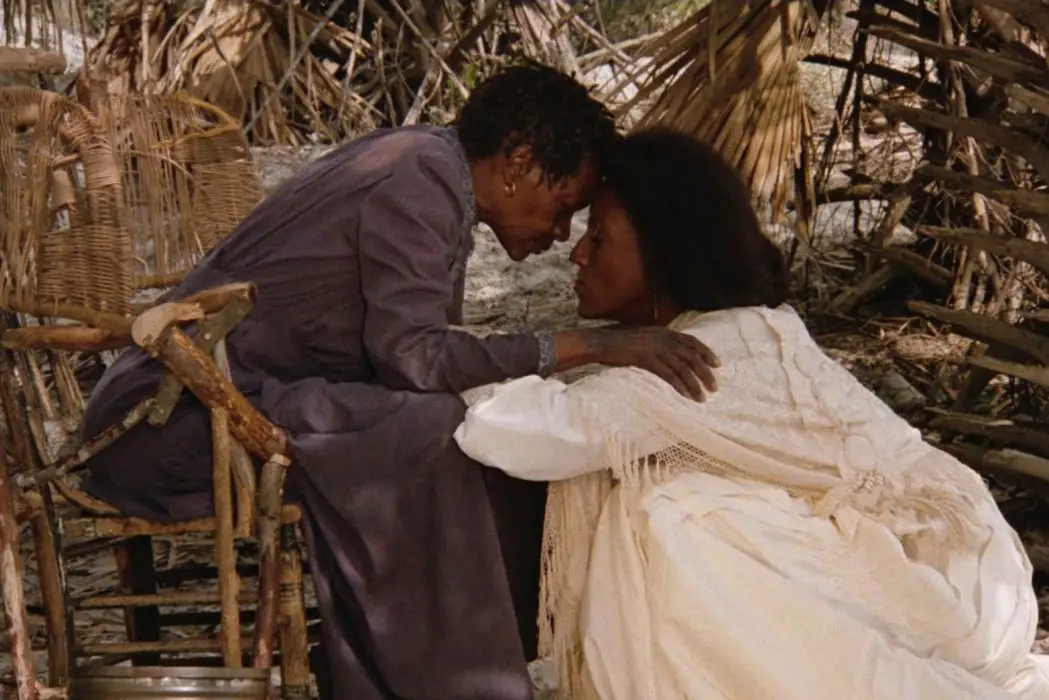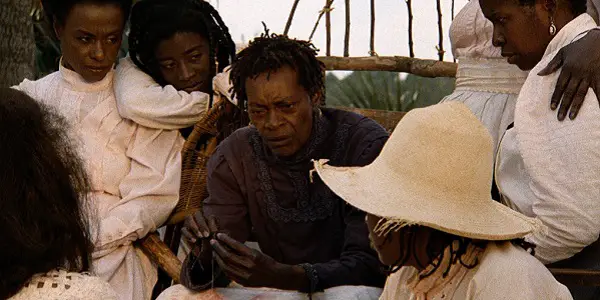DAUGHTERS OF THE DUST: A Dreamlike Vision That Still Rings True

Lee Jutton has directed short films starring a killer toaster,…
Daughters of the Dust is a landmark film in a multitude of ways. Written, directed and produced by Julie Dash, it was the first feature film directed by an African-American woman to be distributed theatrically in the United States when it debuted in 1991. Yes, it took THAT long. The film combines an unconventional, non-linear story structure with dreamlike visuals and narration from an unborn child to bring to life onscreen the unique world of the Gullah people – descendants of West Africans brought to the United States to serve as slaves on Southern plantations, who keep the cultural heritage of their homeland alive in close-knit communities on the Sea Islands.
Much of the film’s dialogue is in the Gullah dialect, which rises and falls with a musical cadence that makes even the most mundane line of dialogue sound poetic, especially when paired with John Barnes’ drumbeat-driven score. Even if you cannot comprehend every word being spoken by the characters, the emotions behind every line resonate, clear and strong.

The influence of Daughters of the Dust’s sensual and surreal imagery, from the flowing white dresses worn by the Gullah women to the sandy beaches and tall grasses of their home on St. Simons Island, can be seen all over a more recent but already-iconic work of art by another African-American woman: Beyonce’s visual album, Lemonade. And while Beyonce Knowles-Carter is far more of a household name than Julie Dash, it’s no surprise that when looking to pay tribute to the strength and vulnerability of black women, Beyonce would draw on Dash’s transcendent work.
To mark the 25th anniversary of the film (and, albeit somewhat coincidentally, to take advantage of the resurgence of interest sparked by Lemonade), Daughters of the Dust has been digitally restored and re-released. And while the film is available on streaming services such as Netflix in the United States, one cannot understate the power of seeing this unique, female-focused film on the big screen.
Meet the Peazants and Their Prodigal Daughters
Daughters of the Dust begins in 1902 with the return to St. Simons Island of two prodigal daughters from the sprawling Peazant clan. While both women left the Sea Islands behind to pursue different lives on the mainland, their paths could not have contrasted more: Viola (Cheryl Lynn Bruce) became a devout follower of Christianity, while Yellow Mary (Barbara-O) – nicknamed as such by her family for her lighter shade of skin – became a prostitute.
Both Viola and Yellow Mary are returning to the island to witness the migration of the rest of the Peazant clan; after generations spent on the Sea Islands, they have finally decided move to the mainland. Yellow Mary is accompanied by her lover, Trula (Trula Hoosier), while Viola has brought along Mr. Snead (Tommy Redmond Hicks), a photographer from Philadelphia, to document this momentous occasion.
As Viola, Yellow Mary and their guests are rowed down the river to Ibo Landing, where their family lives, the audience finds itself being led slowly into a new world, with Dash as our capable guide. It is a world populated entirely by people of color, including Nana Peazant (Cora Lee Day), the stubborn and spiritual matriarch of the family, hands stained with indigo from her years as a slave, reliant on the old ways and unwilling to leave her home behind; Eula (Alva Rogers), a young woman who is pregnant after being raped by a white man, her husband, Eli (Adisa Anderson), who worries the baby might not be his; and Haagar (Kaycee Moore), an outspoken woman whose desire to give her children a more modern life has spearheaded the family’s decision to move north. The majority of the main characters are women, right down to the narrator: Eula’s unborn daughter.
The Last Supper
As the Peazants prepare one last meal together before leaving the island, Mr. Snead snaps photos of their defiant faces arranged along the beach as he listens rapt to the stories of the community elder Bilal Muhammad (Umar Abdurrahamn). A distraught Eula is comforted by Yellow Mary, who was also deemed to have been ruined by a white man but now thrives in her independence. Haagar’s daughter longs for her Native American lover, who refuses to accompany the Peazants off the island.

Viola leads the children in Bible study even as Nana Peazant performs traditional West African folk rituals to keep the family safe. Occasionally, Eula’s unborn daughter is spotted running through the trees, a spiritual guide for the family despite not having been born yet. It’s an altogether dreamy, hazy afternoon, punctuated by poetic fragments of conversation about what it means to be a black woman in both the old world and the new. While the story does build to a main event – the Peazants’ imminent departure – it takes a languid, meandering road to get there, and lacks a traditional story structure with an obvious beginning, middle and end.
Every artistic choice made by Dash and her crew feels incredibly specific to this world, from the frequent use of halting slow-motion to give the hallucinatory illusion that reality has been invaded by the spiritual world to the way Barnes’ eclectic musical score reflects the various cultures of the African diaspora. Even in the film’s most unusual moments, it never feels avant-garde for the sake of it; even in its most surreal scenes, Daughters of the Dust feels like a slice of the lives of very real people.
Who Run the World?
One of my favorite moments in Daughters of the Dust is an anecdote told by Yellow Mary to Eula as they bond over being the family’s frowned upon daughters. One day, Yellow Mary says, she saw a pink silk music box in a shop window. She didn’t have the money to purchase it, but she wasn’t going to ask a man to buy it for her, as she never asks men for anything- she relies only on herself. Nonetheless, Yellow Mary decided to lock away everything bad people had said about her in that pink box. There, she’d keep it – she wouldn’t allow anything in that box to define her. It’s a moment of incredible strength for Yellow Mary and one of incredible inspiration for the audience.

The women of the Peazant clan are women of color in a world where both women and people of color are treated like second-class citizens. Even in their tiny island community, surrounded by reminders of what life was like in Africa before their ancestors were brought to the United States to be slaves, they are forced to deal with the horrors of slavery, lynching and rape. And they face these horrors head-on, speaking their minds even when (and sometimes, because) they are afraid of what is to come. Their stories, told in their own unique and strong voices, are still incredibly empowering today as the voices of women of color continue to be marginalized.
Despite how far we’ve come as a society since 1902, when one sees Sofia Coppola casually erase all women of color from her remake of The Beguiled, or Ana Lily Amirpour subject black characters to brutal violence at the hands of white ones in The Bad Batch, one recognizes the continuing importance of films like Daughters of the Dust. Female-driven films still need to be more intersectional and highlight voices besides that of the white, straight status quo. And while we might have a lot more female-driven films in theaters in 2017, we still don’t have enough that let women like Yellow Mary and Eula speak.
Conclusion
If you find yourself thirsty for more Lemonade this summer, find the time to take in a screening of Daughters of the Dust, and let yourself be drawn down the river into the heart of the Peazant clan. The trip will open your eyes and your mind.
What do you think? Is Daughters of the Dust as relevant today as it was 25 years ago? Share your thoughts in the comments.
The digitally restored Daughters of the Dust is available on streaming services in the U.S. and was released in UK theaters on June 2, 2017.
Does content like this matter to you?
Become a Member and support film journalism. Unlock access to all of Film Inquiry`s great articles. Join a community of like-minded readers who are passionate about cinema - get access to our private members Network, give back to independent filmmakers, and more.
Lee Jutton has directed short films starring a killer toaster, a killer Christmas tree, and a not-killer leopard. Her writing has appeared in publications such as Film School Rejects, Bitch: A Feminist Response to Pop Culture, Bitch Flicks, TV Fanatic, and Just Press Play. When not watching, making, or writing about films, she can usually be found on Twitter obsessing over soccer, BTS, and her cat.












